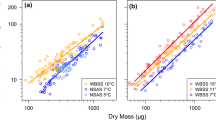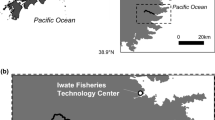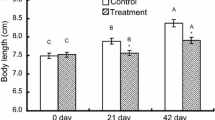Abstract
Early stages of marine fish larvae are characterized by fast growth while having a limited aerobic scope and an immature digestive system. In order to understand this apparent paradox, the study of energy allocation is a major necessity. Components of the energy budget of turbot (Scophthalmus maximus) larvae were determined during initial development (days 4–12) and the complete energy allocation budget is presented. It was observed that food absorption efficiency increased from 32 to 51% during the studied period, and so did the energy available for growth and metabolic purposes. The relative amount of energy for maintenance decreased from 71 to 36% of energy channelled to metabolism. Gross growth efficiency increased from 20 to 26% of ingested energy, and net growth efficiency decreased from 66 to 52% of assimilated energy. Reduction of net growth efficiency is the reflex of a higher metabolic rate in older larvae, due to increased costs of activity and growth. Evidence, indicating that metabolic scope of early turbot larva is unable to accommodate simultaneously high levels of growth and activity was found. Alternative strategies to accommodate the costs of growth and activity exist in turbot larvae, and may result in a trade-off between fast growth and viability. As larvae grow, the various physiological processes described get more efficient, and the metabolic scope increases.


Similar content being viewed by others
References
Blight EG, Dyer WJ (1959) A rapid method for total lipid extraction and purification. Can J Biochem 37:911–917
Brett JR, Glass R (1973) Metabolic rates and critical swimming speeds of sockeye salmon (Oncorhynchus nerka) in relation to size and temperature. J Fish Res bd Can 30:379–387
Brett JR, Groves TDD (1979) Physiological energetics. In: Hoar WS, Randall DJ, Brett JR (eds) Fish physiology, vol 8. Academic, New York, pp 279–352
Cahu CL, Zambonino Infante JL (2001) Substitution of live food by formulated diets in marine fish larvae. Aquaculture 200:161–180
Cho CY, Slinger SJ, Bayley HS (1982) Bioenergetics of salmonid fishes: energy intake, expenditure and productivity. Comp Biochem Physiol B 73:25–41
Conceição LEC (1997) Growth in early life stages of fishes: an explanatory model. Ph.D. Thesis, Wageningen Agricultural University, The Netherlands
Conceição LEC, Houlihan DF, Verreth JAJ (1997a) Fast growth, protein turnover and costs of protein metabolism in yolk-sac larvae of the African catfish Clarias gariepinus. Fish Physiol Biochem 16:291–302
Conceição LEC, van der Meeren T, Verreth JAJ, Evjen MS, Houlihan DF, Fyhn HJ (1997b) Amino acid metabolism and protein turnover in larval turbot Scophthalmus maximus fed natural zooplankton or Artemia. Mar Biol 129:255–265
Conceição LEC, Dersjant-Li Y, Verreth JAJ (1998) Cost of growth in larval and juvenile African catfish (Clarias gariepinus) in relation to growth rate, food intake and oxygen consumption. Aquaculture 161:95–106
Cousin JCB, Baudin-Laurencin F (1985) Morphogenese de l’appareil digestif et de la vessie gazeuse du turbot, Scophthalmus maximus L. Aquaculture 47:305–319
Cunha I, Planas M (1995) Ingestion rates of turbot larvae (Scophthalmus maximus) using different sized live prey. ICES Mar Sci Symp 201:16–20
Cunha I, Planas M (2003) Use of multivariate analysis to assess the nutritional condition of fish larvae from nucleic acids and protein content. Biol Bull 204:339–349
Elliot JM, Davison W (1975) Energy equivalents of oxygen consumption in animal energetics. Oecologia 19:195–201
Finn RN, Fyhn HJ, Henderson RJ, Evjen MS (1996) The sequence of catabolic substrate oxidation and enthalpy balance of developing embryos and yolk-sac larvae of turbot (Scophthalmus maximus L). Comp Biochem Physiol A 115:133–151
Finn RN, Ronnestad I, Meeren T, Fyhn HJ (2002) Fuel and metabolic scaling during the early life stages of Atlantic cod Gadus morhua. Mar Ecol Prog Ser 243:217–234
Finn RN, Rønnestad I (2003) The effect of acute changes in temperature and light on the aerobic metabolism of embryos and yolk-sac larvae of turbot (Scophthalmus maximus). Can J Fish Acuat Sci 60:1324–1331
Fry FEJ (1947) Effects of environment on animal activity. Publs Ont Fish Res Lab 55:5–62
Fyhn HJ (1989) First-feeding of marine fish larvae: are the amino acids the source of energy? Aquaculture 80:111–120
Fyhn HJ (1990) Energy production in marine fish larvae with enphasis to FAA as potential fuel. In: Mellinger J (ed) Animal nutrition and transport processes, 1. Nutrition in wild and domestic animal. Comp Physiol Basel Karger 5:176–192
Giguère LA, Côté B, St-Pierre JF (1988) Metabolic rates scale isometrically in larval fishes. Mar Ecol Prog Ser 50:13–19
Glass NR (1969) Discussion of calculation of power functions with specifical reference to respiratory metabolism. J Fish Res bd Can 26:2643–2650
Gnaiger E (1983) Calculation on energetics and biochemical equivalents of respirometry oxygen consumption. In: Gnaiger E, Forstner H (eds) Polarographic oxygen sensors. Springer, Berlin Heidelberg New York, pp 337–345
Gnaiger E, Kemp RB (1990) Anaerobic metabolism in aerobic mammalian cells: information from the ratio of calorimetric heat flux and respirometric oxygen flux. Biochem Biophys Acta 1016:328–332
Govoni JJ, Boehlert GW, Watanabe Y (1986) The physiology of digestion in fish larvae. Environ Biol Fish 16:59–77
Higgs DM, Fuiman LA (1996) Ontogeny of visual and mechanosensory structure and function in Atlantic menhaden Brevoortia tyrannus. J Exp Biol 199:2619–2629
Houde ED (1987) Early life dynamic and recruitment variability. Am Fish Soc Symp 2:17–29
Houlihan DF, Pannevis M, Heba H (1993) Protein synthesis in juvenile tilapia (Oreochromis mossambicus). J World Aquacult Soc 24:145–161
Houlihan DF, Pedersen BH, Steffensen JF, Brenchin J (1995) Protein synthesis growth and energetics in larval hearring (Clupea harengus) at different feeding regimes. Fish Physiol Biochem 14:195–208
Kiørboe T (1989) Growth in fish larvae, are they particularly efficient? Rapp P-v Reun Cons int Expl Mer 191:383–389
Kiørboe T, Munk P, Richardson K (1987) Respiration and growth of larval herring Clupea harengus: relation between specific dynamic action and growth efficiency. Mar Ecol Prog Ser 40:1–10
Kiørboe T, Møhlenberg F (1987) Partitioning of oxygen consumption between maintenace and growth in developing herring Clupea harengus (L.) embryos. J Exp Mar Biol Ecol 111:99–108
Lowry OH, Rosenbrough NJ, Farr AL, Randall RJ (1951) Protein measurement with the folin fenol reagent. J Biol Chem 193:265–275
Lucas MC, Priede JC (1992) Utilization of metabolic scope in relation to feeding and activity by individual and grouped zebrafish, Brachydanio rerio (Hamilton-Buchanan). J Fish Biol 41:175–190
Miller TJ, Crowder LB, Rice JA, Marschall EA (1988) Larval size and recruitment mechanisms in fishes: towards a conceptual framework. Can J Fish Aquat Sci 45:1657–1670
Morais S, Koven W, Rønnestad I, Dinis MT, Conceição LEC (2005) Dietary protein/lipid ratio and lipid nature affects fatty acid absorption and metabolism in a teleost larva. Br J Nutr 93:813–820
Munilla-Morán R, Stark JR (1989) Protein digestion in early turbot larvae, Scophthalmus maximus L. Aquaculture 81:315–372
Munilla-Morán R, Stark JR, Barbour A (1990) The role of exogenous enzymes in digestion in cultured turbot larvae. Aquaculture 88:337–350
Oikawa S, Itazawa Y (1984) Allometric relationship between tissue respiration and body mass in carp. Comp Biochem Physiol A 77:415–418
Osse JWM, van den Boogaart JGM (1995) Fish larvae, development, allometric growth, and the aquatic environment. ICES Mar Sci Symp 201:21–34
Pankhurst PM, Butler P (1996) Development of the sensory organs in the greenback flounder, Rhombosolea tapirina. Mar Freshw Behav Physiol 28:55–73
Peterson I, Wroblewski JS (1984) Mortality rate of fish in the pelagic ecosystem. Can J Fish Aquat Sci 41:1117–1120
Post JR, Lee JA (1996) Metabolic ontogeny of teleost fishes. Can J Fish Aquat Sci 53:910–923
Ricker WE (1979) Growth rate models. In: Hoar WS, Randall DJ, Brett JR (eds) Fish physiology, vol 8. Academic, London, pp 677–707
Rombough PJ (1994) Energy partitioning during fish development: additive and compensatory allocation of energy to support growth? Funct Ecol 8:178–186
Rønnestad I, Conceição LEC (2005) Aspects of protein and amino acids digestion and utilization by marine fish larvae. In: Starck JM, Wang T (eds) Physiological and ecological adaptations to feeding in vertebrates. Science Publishers, Enfield, New Hampshire, USA
Rønnestad I, Fyhn HJ, Gravningen K (1992) The importance of free amino acids to the energy metabolism of eggs and larvae of turbot (Scophthalmus maximus). Mar Biol 114:517–525
Rønnestad I, Thorsen A, Finn RN (1999) Fish larval nutrition: a review of recent advances in the roles of amino acids. Aquaculture 177:201–216
Salgado-Alvarez XA (1993) Mecanismos de transporte e balance bioxeoquímico de nitroxeno na Ria de Vigo. Ph.D thesis, University, Santiago de Compostela, Spain
Schmidt-Nielsen K (1984) Scaling. Why is animal size so important?. Cambridge University Press, Cambridge
Segner H, Storch V, Reinecker M, Kloas W, Hanke W (1993) A tabular overview of organogenesis in larval turbot (Scophthalmus maximus L.). ICES Mar Sci Symp 201:35–39
Strickland JD, Parsons TR (1968) A practical handbook of seawater analysis. Bull Fish Res bd Can 167, 311p
Weihs D (1980) Energetic significance of changes in swimming modes durind growth of larval anchovy, Engraulis mordax. Fish Bull USA 77:597–604
Wieser W (1985) Developmental and metabolic constraints of the scope for activity in young rainbow trout (Salmo gairdnerii). J Exp Biol 18:133–142
Wieser W (1994) Cost of growth in cells and organisms: general rules and comparative aspects. Biol Rev 68:1–33
Wieser W, Forstner H, Medgyesy N, Hinterleitner S (1988) To switch or not to switch: partitioning of energy between growth and activity in larval cyprinids (Cyprinidae:Teleostei). Funct Ecol 2:499–507
Wieser W, Kaufmann R (1998) A note on interactions between temperature, viscosity, body size and swimming energetics in fish larvae. J Exp Biol 201:1369–1372
Yamashita Y, Bailey KM (1989) A laboratory study of the bioenergetics of larval walleye pollock, Theragra chalcogramma. Fish Bull 87:525–536
Acknowledgments
This study was financially supported by the Comisión Interministerial de Ciencia y Tecnología (CICYT, Spain) under Project AGF 185/92. Isabel Cunha was supported by a doctoral fellowship from FCT–Program Praxis XXI–BD/3489/94. We would like to thank to E. Gomes, Animal Nutrition Laboratory, ICBAS, Porto, for the use of the calorimetric bomb; to M. López and J. Quiñones, ASM soft and Escuela de Peritos, Vigo, for the automation of the respirometric data capture, and finally; to J. Salgado-Alvarez and M.J. Pasó, Oceanography Laboratory, IIM, CSIC, Vigo, for the analysis of nitrogen compounds.
Author information
Authors and Affiliations
Corresponding author
Additional information
Communicated by S.A. Poulet, Roscoff.
Rights and permissions
About this article
Cite this article
Cunha, I., Conceição, L.E.C. & Planas, M. Energy allocation and metabolic scope in early turbot, Scophthalmus maximus, larvae. Mar Biol 151, 1397–1405 (2007). https://doi.org/10.1007/s00227-006-0576-x
Received:
Accepted:
Published:
Issue Date:
DOI: https://doi.org/10.1007/s00227-006-0576-x




